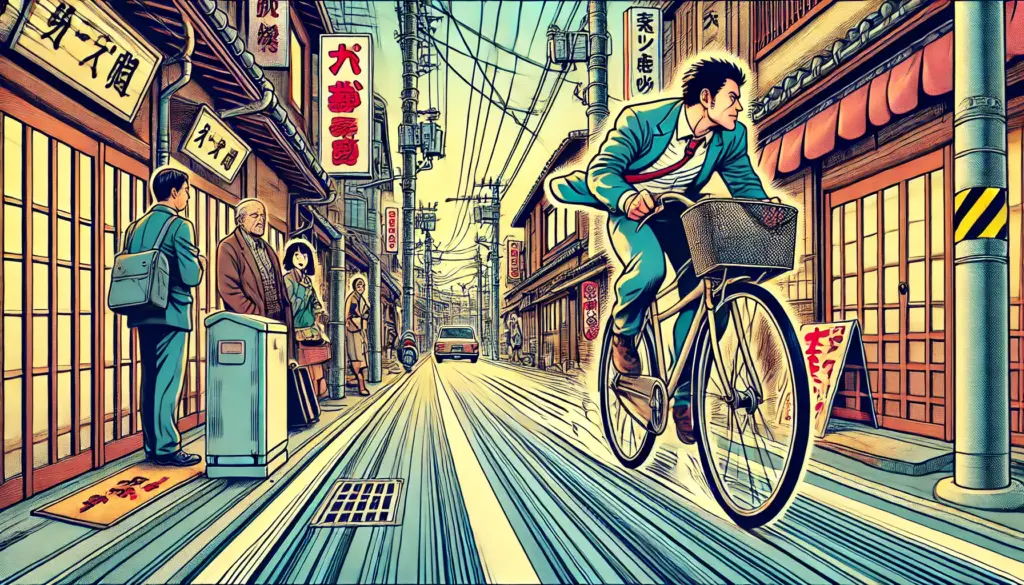
When walking along Japan’s sidewalks, many residents and visitors alike have shared one common experience: the sudden rush of a bicycle racing past within inches of their shoulders. 🚴♀️ In a country known for its orderly society and strict traffic regulations, why are bicycles often allowed to ride freely on sidewalks—sometimes at dangerous speeds? And why do so many people feel nothing is being done to address the risk?
This article explores the background of Japan’s sidewalk cycling culture, the risks pedestrians face, and the reasons why the issue has remained largely unchecked despite mounting concerns.
🚶 The Reality of Narrow Japanese Sidewalks
Unlike many Western cities, Japanese sidewalks are often extremely narrow. In older urban neighborhoods, roads were designed long before cars and modern traffic standards became common. Some sidewalks measure less than a meter wide, forcing pedestrians and cyclists to share limited space.
In crowded areas, this means:
- Pedestrians dodge bicycles brushing past.
- Parents with strollers struggle to move safely.
- Elderly people face heightened risk of falling after a sudden encounter.
For many people, even a short walk through their neighborhood can feel like navigating a constant safety hazard.
🚲 Why Bicycles End Up on Sidewalks
At first glance, it seems obvious that bicycles should use the road, not the sidewalk. However, several cultural and legal factors explain why the practice continues:
- Historical Policy Decisions
In the 1970s, Japan allowed bicycles on sidewalks to reduce car-related accidents involving cyclists. The rule was originally meant to be temporary but became deeply ingrained in urban life. - Road Space Limitations
Many Japanese roads lack dedicated bike lanes. With cars, buses, and trucks dominating narrow roads, cyclists often feel safer on sidewalks, even if it puts pedestrians at risk. - Weak Enforcement
Police rarely issue warnings or fines unless a serious accident occurs. Most cyclists assume riding on the sidewalk is tolerated, if not entirely legal. - Cultural Habits
For decades, Japanese families have taught children to cycle on sidewalks as the “safe” option. This cultural habit remains hard to overturn.
⚠️ The Hidden Dangers for Pedestrians
While many cyclists believe they are avoiding danger by staying off the road, pedestrians are the ones who suffer.
Common risks include:
- Collisions with the elderly – even a low-speed crash can cause serious injuries.
- Silent approach – bicycles often glide silently, startling pedestrians at the last moment.
- High speeds – delivery riders and commuters sometimes treat sidewalks as racetracks.
- Shared blind spots – sharp turns, shop entrances, and narrow alleys make sudden encounters unavoidable.
For tourists unfamiliar with Japan, the sight of bicycles weaving through sidewalks often comes as a shock compared to stricter rules abroad.
📉 Why Doesn’t Japan Crack Down?
This is the question many ask: if so many pedestrians feel endangered, why does the system remain unchanged?
Several reasons help explain:
- Economic dependence on bicycles
In urban Japan, bicycles are essential for commuting, shopping, and even elderly mobility. A strict ban could cause backlash. - Low number of fatal accidents
Compared to car collisions, bicycle-pedestrian accidents rarely make national headlines. Without major public pressure, policymakers see little urgency. - Police discretion
Officers often prioritize “social harmony” over strict enforcement, allowing bicycles to continue using sidewalks as long as no serious harm is caused. - Infrastructure gap
Building bike lanes across dense Japanese cities requires massive urban redesign, which is politically and financially difficult.
🌍 How Japan Compares to Other Countries
In Europe, bicycles are often celebrated as eco-friendly transport, but dedicated lanes keep them separate from pedestrians. Countries like the Netherlands and Denmark have clear rules: sidewalks are for walkers, roads and lanes are for bicycles.
In Japan, however, the blurred line creates tension. What would be considered reckless in other nations is normalized here. For many foreigners, this contradiction seems surprising—especially given Japan’s reputation for meticulous order in other areas of life.
🔮 What Could Change in the Future?
There are signs that attitudes may slowly shift:
- Local governments experimenting with bike lanes in cities like Tokyo and Kyoto.
- Awareness campaigns encouraging cyclists to slow down near pedestrians.
- E-bike growth which may accelerate demand for clearer regulations.
- Tourism pressure as visitors voice concerns about safety.
Still, without stronger enforcement or major infrastructure investment, it is unlikely that sidewalk cycling will disappear soon.
💡 A Balanced Perspective
While sidewalk cycling poses real dangers, it also reflects Japan’s unique urban challenges. Narrow roads, high population density, and limited budgets make bike-specific infrastructure difficult. For now, pedestrians and cyclists continue to share the same contested space.
The real solution may not be a total ban but a clearer set of rules:
- Speed limits for bicycles on sidewalks.
- Priority to pedestrians at all times.
- Expansion of dedicated cycling zones in high-traffic areas.
✅ Conclusion
Japan’s sidewalks remain a battleground between safety and convenience. While many people have had frightening experiences with bicycles racing past them, the issue persists because of historical habits, weak enforcement, and urban design limitations.
For visitors and residents alike, the lesson is clear: stay alert when walking in Japan—sidewalks are not always safe havens. 🚶♂️🚴♂️
Until Japan decides to redesign its urban infrastructure, pedestrians and cyclists will remain uneasy neighbors on the nation’s narrow pathways.



















































